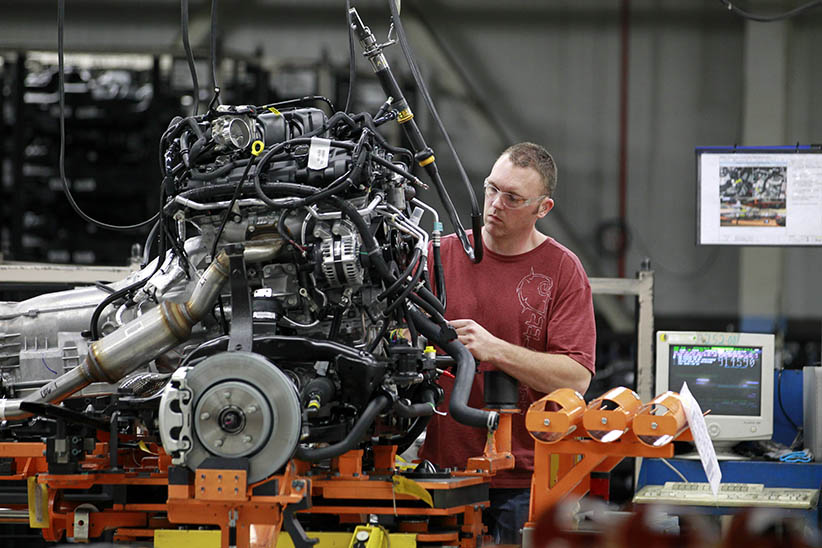How Ottawa’s budget will influence manufacturing and internal trade
Manufacturing will be a hot topic in battleground Ontario. And the industry should be pleased today, says Mike Moffatt.
A Chrysler Group LLC employee inspects an engine on the production line of the company’s Jefferson North Assembly Plant in Detroit, Michigan, U.S., on Thursday, April 28, 2011. Chrysler Group LLC, the automaker run by Fiat SpA, plans to repay $7.53 billion in loans from U.S. and Canadian governments this quarter as it moves toward an initial public offering and merger with its Italian partner. ( Jeff Kowalsky/Bloomberg/Getty Images)
Share

With the oil industry reeling from low prices and Southwestern Ontario a key battleground in the next election, it should come as no surprise to find an emphasis on manufacturing in the budget. Unlike Budget 2014, which was sprinkled with references to manufacturing, the 2015 edition contains both a subchapter and annex titled “Supporting the Manufacturing Sector.” The industry should be pleased—though there will be some disappointment at the lack of policies around market access to the United States.
The most notable change for manufacturers is a 10-year extension of the accelerated capital cost allowance (ACCA) provisions, which were set to expire this year. The ACCA allows manufacturing companies to depreciate, for tax purposes, the value of newly purchased equipment and machinery at the accelerated rate of 50 per cent per year, reducing their taxable income in the first few years of owning the asset. If there is a surprise here for manufacturers, it is not so much that the measure was extended, but rather in the length of the extension, as the previous extension only covered two years.
Manufacturers will be delighted by the tax savings and regulatory certainty from a 10-year extension, though the evidence on its effectiveness in promoting new investment is mixed. That is the only major tax measure for manufacturers in the budget, though some smaller companies may benefit from reductions in the small business tax rate that begin in 2016.
Any doubt on the electoral importance of Southwestern Ontario should be eliminated through the announcement of new money earmarked to automotive parts suppliers. The budget creates an Automotive Supplier Innovation Program, designed to assist parts manufacturers in developing new products. The government has allocated $100 million to the program, though $50 million of this is simply reallocated from the Automotive Innovation Fund. The remaining $50 million given to automotive parts manufacturers will be phased in over five years, along with $22 million for defence contractors and $12 million for the aerospace industry.
Despite a decade of job losses in manufacturing, companies in Southwestern Ontario indicate that skills shortages are an issue for their firms. The budget seeks to address these skills shortages through a number of measures, including $65 million to assist post-secondary institutions to revise their curricula to better align with industry needs.
Further to the issue of skills shortages, the government has announced the re-allocation of $4 million for a “labour market information portal” and another $7 million to “support the relocation of youth and immigrants to areas where job opportunities exist.” Given the modest sums involved and that this is not new money, the effect of these policies is likely to be extremely modest.
[widgets_on_pages id=”FederalBudget”]
While these new measures will benefit the industry, manufacturers in Ontario may be disappointed in the lack of policies designed to assist companies in getting goods to the United States in a timely and consistent manner. None of the new money devoted to infrastructure appears to be specifically earmarked for this purpose, and the border policies in the budget are re-announcements of existing measures, like the Beyond the Border Action Plan.
There is new money for exporters set aside under “Enhancing the Trade Commissioner Service,” tasked with helping companies gain access to overseas markets. The overall effect on exports from this policy is likely to be modest given that Ontario’s goods exports to Michigan dwarf those to China. Exporters to other provinces may also benefit from the creation of an Internal Trade Promotion Office. If this office can be effective in identifying and reducing internal trade barriers, it may be of some benefit to manufacturers.
The overall fiscal effects of the changes to manufacturing policy and advanced research are backdated, with a cost of only $10 million in fiscal year 2015-16. Southwestern Ontario manufacturers who may be underwhelmed by the budget are reminded of past triumphs, including the elimination of tariffs on manufacturing inputs, an $80 million dollar loan for a Ford expansion in Windsor, the Factory of the Future project in London and funds for Fibracast in Hamilton through the Advanced Manufacturing Fund.
While tales of old are no substitute for new victories and a lack of focus on the American market is a concern, manufacturers did quite well—especially given that we have a government devoted to balancing the budget.